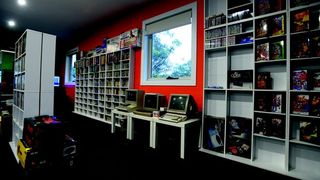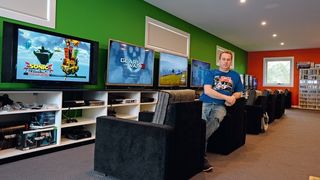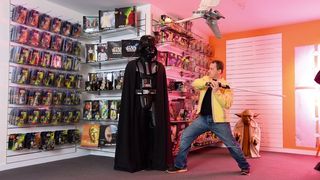Every generation longs for the comforts of the past, but the business of nostalgia has never been so lucrative. Series more than 20 years old are back on television or being adapted for the silver screen; remakes and reboots are rife – circumstantially, even the decades-obsolete Sony Walkman tape player has made cameos in big-budget movies and videogames. And games themselves are just as subject to the trend. In the hands of a solid designer, old-fashioned notions can become the impetus for something new, but for every XCOM or Fez, there’s a game with little to recommend it beyond calling back to a bygone era.

Joel Hopkins may feel the tug of nostalgia more than most, but he’s not just sentimental about the past: he preserves and showcases it. The owner of what he claims is the world’s largest collection of videogames, Hopkins has over 18,000 titles stored in his purpose-built home, nestled in the green suburban hills of Melbourne, Australia. Displayed carefully, proudly, in a room freshly painted with bright colours – finished mere days before I visit – each title is carefully catalogued, ordered and set out almost like it’s in a game store. Along a long wall, every major console from the past 43 years is connected to a TV that’s been specifically chosen to showcase its games at their best. There’s another room – an annex, in fact – entirely dedicated to housing coin-operated arcade machines.
Although Hopkins has been collecting for more than 20 years, this year he’s ramping up the stakes. He is in talks with Guinness for claiming the World Record title, and he’s also increasing the number of videos he’s publishing on his YouTube channel, Last Gamer. He has some 13,000 subscribers currently, which is insignificant next to the biggest YouTube gaming channels, but Hopkins says he’s just getting started, and having such a large collection provides him with a galaxy of options for content.
What’s the motivation behind collecting such a library? According to Hopkins, there isn’t any financial gain to be made – he cringes at the mention of selling up – and he’s not ready to donate any of the rarer titles to a museum either. (“It would kill me,” he says.) He bristles at the very thought of putting ads on his videos. No. The impetus here, it turns out, is simple pride.

“No one would expect an Australian guy to have the world’s biggest collection,” he says. “You wouldn’t think it’s possible. Games are more expensive here, too. You go to flea markets in the States and they’re selling games for a dollar or two. Here, they’re harder to find.” Yet the room we’re in feels like a traditional bricks-and-mortar store from the 1990s that’s fallen through time, shelf after shelf of games inviting you to skim the spines of Commodore 64 curios and 360 hits alike, as well as everything in between. A Virtual Boy sits proudly on its tripod atop one glass display case, while a limited-edition Metal Gear Solid V PS4 is perched with equal prominence on the adjacent cabinet, which happens to be full of 3DSes in various trims.
Hopkins’ dedication to building this giant space with his own hands sets him apart from other collectors. Where they might fill a few shelves while boxes overflow in garages and lofts, Hopkins is dealing with builders and construction materials. He’s also getting his hands dirty, and loving it. “I’ve built this space,” he says, “and with YouTube I showed people along the way how I was building it.” It doesn’t just stop at games: Hopkins also has a THX-certified home cinema, which he designed and built himself. (It helps that he used to build similar rooms for a living.) A lot of planning, discipline and coordination goes into building a project of this size.
There’s something quaint about this collection of physical games, but showing off this type of library is always going to attract attention, so what better place to showcase it than YouTube? The sheer willpower involved draws some notice, as evidenced by the thousands of views for similar endeavours. There is also a greater interest in collecting within the industry now; three years ago, a collection of several thousand games was listed for a million Euros on eBay.
Indeed, Hopkins says that part of the reason for ramping up the production of videos for his channel is competition with other collectors. At 41, he feels he has a breadth of knowledge that younger broadcasters simply don’t possess. “I don’t know anybody else like me,” he says, although at the same time he dismisses the idea his channel is meant as a showcase for his personality. “I don’t want to show off. I’m just some guy. But I see collections on YouTube and I think, ‘Those collections are not that big.’ But also, I see people reviewing games, and they’re just making stuff up. They’ll talk about a level in the game and it’s not correct. That pisses me off a little bit.”
He points to his extensive collection of coin-op cabinets, noting that collectors on YouTube usually focus on either consoles or arcade hardware. “I’m the only one who does both,” he says. “I’ve got a whole collection of games. I could review any game I want, and I can review it on every single system. So that’s what I want to do.”
Hopkins is in self-professed “rampage” mode at the moment. The day after our interview, he’s due to pick up a shipment of several hundred PS3 and 360 games. As with all obsessions, his quest to collect so many titles becomes more understandable when put in context. As a child, he fell in love with video games, starting with an Atari VCS in the late 1970s. Moving into his teens, he dabbled with piracy, downloading games from bulletin boards using the Internet connection at his workplace. (In a strange coincidence, he was acquainted with Julian Assange at the time, the two of them attending computer swap meets together.) “I’m against piracy now,” he says. “It was just a time of innocence back then. It was just good times.”

Hopkins then opened his own video game store in the early ’90s, importing games – often from Japan – and selling them months before they were freely available at Australian chains. “I had 300 copies of Street Fighter 2 in my first shipment,” he recalls. “Within two weeks, they were all gone.” Eventually, the store shut down, following Sony and Nintendo taking action against him for parallel imports. “I didn’t want to have to deal with them, because I wasn’t going to make any money,” Hopkins says. “But I had people coming from everywhere in the state to buy from my little shop. It was the best time to be around.”
Hopkins’ stories are drenched with nostalgia. With no allegiance to one franchise or console, he says it wasn’t any particular technology that captured his attention. He just liked getting wrapped up in another world. It’s partly why he doesn’t care about his collection being in mint condition, and why many copies of games are his own from more than 30 years ago. He points at a The Legend Of Zelda 3: A Link To The Past cart. “That’s my original copy. That’s important to me,” he says. Since a few scratches don’t bother him, he’s happy for his young son to play with any game that catches his attention.
“They’re my games. I have memories of the copy of The Last Ninja my mother bought me, and that copy is priceless. It’s got the price sticker on it and everything, but I don’t want a pristine copy just to say it’s pristine. I don’t throw things around – I’m fussy – but if something gets a bit scratched, if there are some faint lines on it or whatever, it doesn’t bother me.” But a love for games does not a collector make, and the motivation for buying so many of any given category of possessions always treads a fine line. Is there a point at which Hopkins’ quest becomes a cause for concern, rather than an achievement?

It’s a matter of personality, Hopkins says. While he’s always been passionate about video games and technology in general, it requires a type of obsessive personality to track down so many. And it’s a trait that has spilled over into different aspects of his life. “When I get into something, I really get into it,” he says. “I don’t do it half-assed.” Hopkins is hardly a reclusive hoarder – he often has friends and family over to enjoy his collection, found financial success through the stock market, and has a successful business repairing pinball machines. But his obsession seeps into other aspects of his life. When he sees something he wants, he says, nothing can change his mind.
In other rooms of his large home, Hopkins shows off his collection of RC cars. His home office is lined with boxed Star Wars figurines from various eras. They’re carefully displayed on hooks, just as they would be in a store. Many of the model cars remain in their boxes. Hopkins’ desire to collect doesn’t stop at the miniature versions, either. “If I get money, I want a Ferrari. Now I want two. Then I want a Lamborghini. It’s that type of mentality of never stopping, and it gets me into trouble,” he says. “Once I started with games, I never stopped.”
While Hopkins has no debt and spends all of his free cash on cars and games – he owns both of his homes outright – his time in the stock market took something of a toll. He describes sleepless nights charting stocks and closely watching when prices would reach their most opportune points. “It was very difficult,” he says, “You become so focused on the end result, it’s just go, go, go – there’s a breaking point. I don’t stop. That’s my problem.”
The pace of Hopkins’ quest has begun to temper, though. During the ’90s, gathering games became a financial struggle for him. “I was really going beyond my means – that was hard. I’ve got enough funds now to know when to wait for a good deal. I used to see a game worth $200 and think that I’d have to have it, but now I can just let it go and wait six months for when it’s half the price.”
And yet with the increased wisdom of age apparently comes the longing of youth. Hopkins elaborates on why so many of the old games were the best – the typical answers of simpler graphics, a focus on gameplay, and so on – but other aspects of his personality hanker for the past too. His home is filled with shrines to the ’80s and ’90s, film posters of Star Wars, Star Trek and other pop-culture memorabilia displayed in full view.

It was the trappings of the era, not the culture itself, that really won Hopkins over. “No one knew what to do with computers at the time,” he says. “You talked to other people and they didn’t know what was going on. In the 1980s, there was so much possibility. Big things happened. Now things are not really buzzing any more. Things are better here, better there, but not as exciting, I think.”
This mentality has seemingly seeped into video games in the past few years. Space flight simulations are returning to prominence after a period of relative quiet, with Elite: Dangerous, No Man’s Sky and Star Citizen all attempting to realise the promise of infinite horizons made by computing in the ’70s. Meanwhile, updates of older titles, such as XCOM: Enemy Unknown and King’s Quest, have seen great success by tapping into the sense of longing that Hopkins describes.
Part of this is easy to explain: older creators have returned to their favourite stomping grounds via crowdfunding, and the children of the ’80s and ’90s are now old enough to own studios. But the psychology of nostalgia is complex. For instance, studies have shown that sadness is often a trigger for nostalgic longings. In 2013, Jamie Madigan wrote in these very pages that research has found people who get easily nostalgic have higher self-esteem and find it easy to trust others. Stimuli even as basic as a song can trigger this type of response, and research has shown that most people recall social contexts when discussing the past – and it also shows that people who lack a social connection experience nostalgia the most acutely.

Hopkins describes inviting his friends to play networked Gears of War – his favourite series from the past decade – just weeks before. “I nearly had tears in my eyes,” he says. “We always used to play Gears of War. We’d start after dinner and play until four in the morning. Now there are days when I walk in, and I put on a game just to hear the music.”
It would be easy to dismiss Hopkins’ goal as being nothing more than the venture of a man dedicated to reclaiming his lost youth. But he isn’t dismissive of the current generation – “I’ll try anything,” he says – even though he laments the evolution of games from physical to digital media. After all, a big collection of digital games doesn’t look particularly interesting on a shelf.
There are still many thousands of games to collect, and the goal is to own every title for every major console. A finite number of games suggests an end point, a marker where Hopkins could say that he’s finished. But it’s unlikely just having it all would be enough. “I could just stick an SD drive in a Mega Drive cartridge and have every game for that console,” says. “Done. But there’s nothing like a full library where you can see it,” he says. “I can’t get out of it now. I’m in deep.”
Read more from Edge here. Or take advantage of our subscription offers for print and digital editions.

